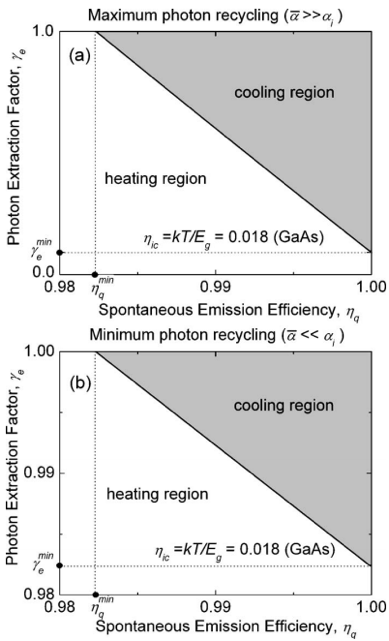Photon extraction factor vs spontaneous emission efficiency for the maximum photon recycling case in a and for the minimum photon recycling case in b. The cooling efficiency is positive in the shaded area and zero along the solid line. The ideal cooling coefficient ic=kT/Eg used is for the GaAs band gap energy. 04
J.-B. Wang, et al., J. Appl. Phys. 100, (4), 043502 (2006).
Luminescence refrigeration in semiconductors is studied using a model that includes the rate equations for carriers and photons as well as the influence of spectral dependent photon recycling. Expressions are derived for cooling efficiency, cooling power density, and the minimum external quantum efficiency required for cooling. These results show that net cooling is accessible and that photon recycling significantly contributes to luminescence refrigeration when the luminescence extraction is small.
Electroluminescence refrigeration in light emitting diodes is studied by taking into account carrier transport, carrier recombination, and influence of the dimensionality of electronic density of states (DOS) in active region. The cooling process happens when carriers transport from the metal contacts to the barrier layers. For a given bias voltage, the cooling power density decreases monotonically with the dimension of the DOS and increases as the carrier effective masses increases
S.-N. Wu, et al., J. Vac. Sci. Technol. B29, 031213- 031219 (2011).
A light emitting active region with three InGaAs quantum wells is monolithically integrated with a GaAs hemisphere as a means to increase the extraction efficiency of light emitting diodes. For a device with a small active region and large hemisphere and optimal antireflection, theoretical calculations show that the extracted fraction of spontaneous emission incident on the hemisphere is greater than 99.9% and the overall extraction efficiency of the integrated device is as high as 90%. The fabrication results show that near perfect GaAs hemispheres can be successfully integrated with light emitting active regions.



